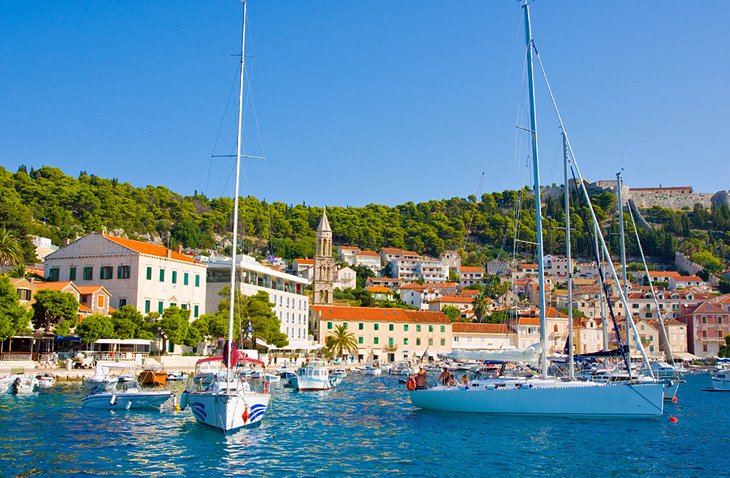
You must see Croatia and Slovenia at least once and the local weather
Croatia and Slovenia attractions, top destinations selection and the region weather? Dubrovnik, Croatia’s most glamorous tourist destination and a UNESCO World Heritage site, centers on the magnificent Old Town area, contained within sturdy medieval defensive walls. Any first-time sightseeing tour of the city should begin with a walk around these sturdy old ramparts (the complete circuit measures two kilometers), which incorporate fortresses, towers, and cannons along the way. You’ll also likely enter the Old Town through the famous Pile Gate, built in 1537 and one of the city’s most impressive structures. From high up on the walls, you can enjoy amazing views over the Old Town rooftops and out across the glistening Adriatic Sea (be sure to wear comfortable walking shoes and bring bottled water-and a selfie stick).
Franja Hospital served as Partisan Hospital during World War II. Located in the Pasica gorge, it was hidden from the enemy and saved the lives of many men and women. After the war, Franja became a museum and was open to visitors until a devastating flood in 2007. Luckily, the hospital was reconstructed, and the new hospital is almost an exact replica of the old hospital. Now, the fourteen cabins that form Franja Partisan Hospital are once again open to visitors.
Island Hvar and especially Hvar town is one of the most popular attractions in Croatia. Olive groves, fruit orchards, and lavender fields make up a large part of the agricultural landscape. Hvar town, set in a picturesque natural bay, with the Pakleni island chain protecting it to the south, is a popular port for yachts sailing around the Adriatic, especially in the summer months. Starigrad, the oldest village on the island, and Jelsa, as well as a smattering of small villages, dotting the coast or nestled in the lush interior are also well worth a visit.
The capital city of Croatia – Zagreb has a host of surprises under its belt. For those with artistic bend a little love for the Medieval Era, Zagreb is perhaps the best place to start. Full of historical sites, theaters, galleries, and museums, this town offers a unique taste of Medieval times that cannot be ignored. The famous Jarun lake is yet another attraction that calls for the partying folks more than anyone else. With lake-side discos, this lake has a jovial and free-spirit nature that attracts the ones that love to enjoy life to the fullest. For those with a slightly different taste of tranquility, a refreshing swim or a lazy sailing on the silent waters can be just as magical as one can think of. Find more info at Pag weather.
The 10th Omis Guitar Fest will take place 17th to 22nd June 2020, with both guitar professionals from the local region and abroad taking part. The festival features masterclasses, workshops and concerts, and there is also a competition with various categories. Makarska kicks into life from June until September. Occurring almost (but not strictly) every week in July and August, Makarska’s Fishermen’s night sees a sprightly folk festival animate the waterfront. A celebration of local culture specifically for visitors, it’s a great opportunity to snag some fresh fish and seafood, washed down with local Croatian wine. The festival sees people milling about in traditional costume and attendees participating in fun, simple games like balancing on a beam to the soundtrack of Dalmatian music.
According to ancient legend, the tranquil beauty of the island of Mljet impressed the hero Odysseus so much that he stayed here for 7 years. Considering everything there is to do on the island, visitors today might be tempted to stay just as long. Most of the island is taken up by Mljet National Park, which offers spectacular pine forests, two saltwater lakes, and a secluded seaside cave. There are plenty of man-made attractions here as well, including a Benedictine monastery, tombs that date back to the Illyrian period, and the ruins of a large 5th-century Roman palace. See even more information on https://vreme-si.com/.
Recent Posts
Tags
Recent Comments
Categories
Archives
- February 2025
- April 2024
- February 2024
- January 2024
- December 2023
- November 2023
- October 2023
- September 2023
- August 2023
- July 2023
- May 2023
- April 2023
- March 2023
- February 2023
- January 2023
- December 2022
- November 2022
- October 2022
- September 2022
- August 2022
- July 2022
- May 2022
- March 2022
- January 2022
- December 2021
- November 2021
- October 2021
- September 2021
- August 2021
- July 2021
- June 2021
- May 2021
- April 2021
- February 2021
- December 2020
- November 2020
- October 2020
- September 2020
- August 2020
- July 2020
- June 2020
- April 2020
- March 2020
- February 2020
- January 2020
- December 2019
- November 2019
- October 2019
- September 2019
- August 2019
- July 2019
- June 2019
- May 2019
- April 2019
- March 2019
- February 2019
- November 2018
- October 2018
- September 2018
- August 2018
- July 2018
- May 2018
- February 2018